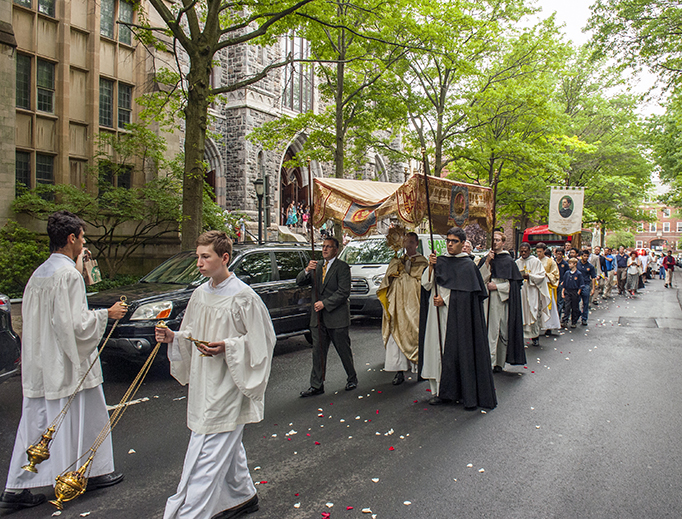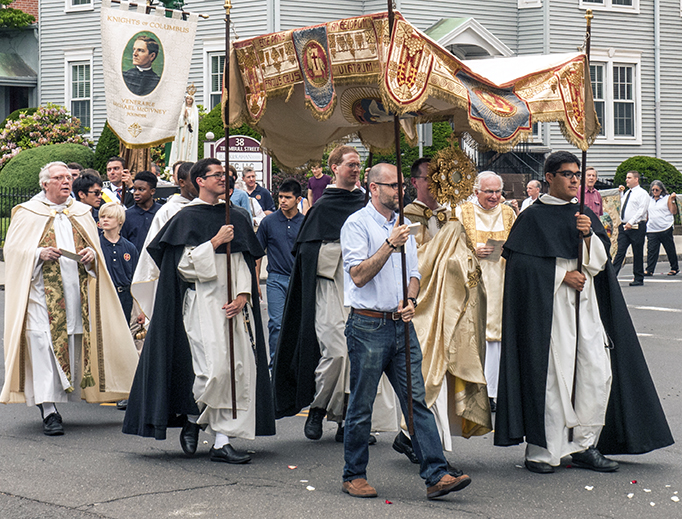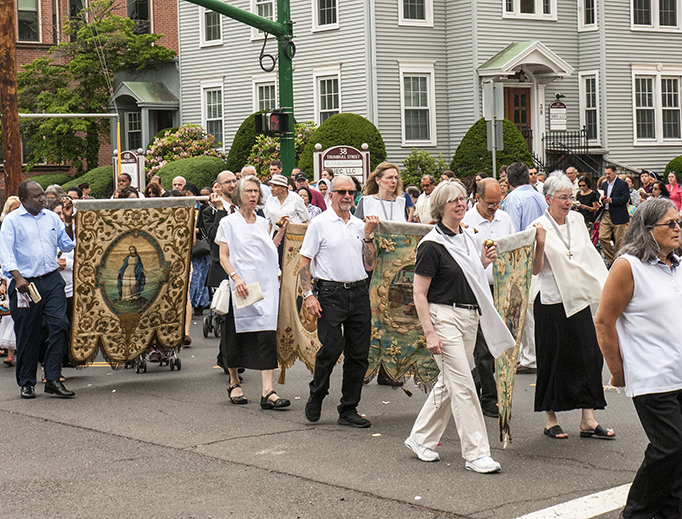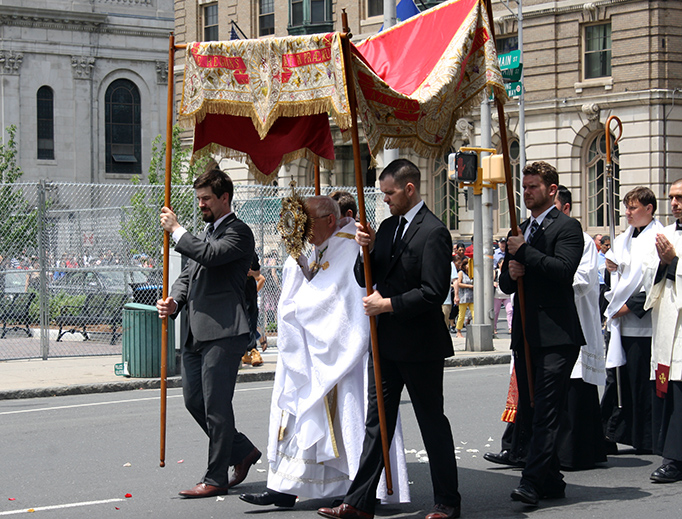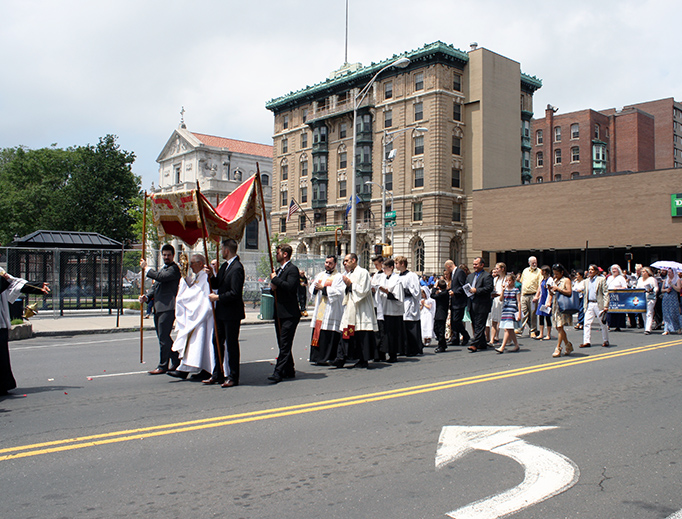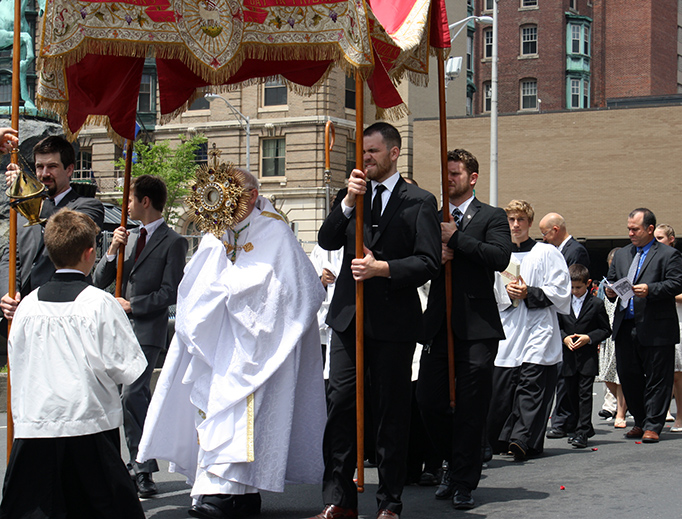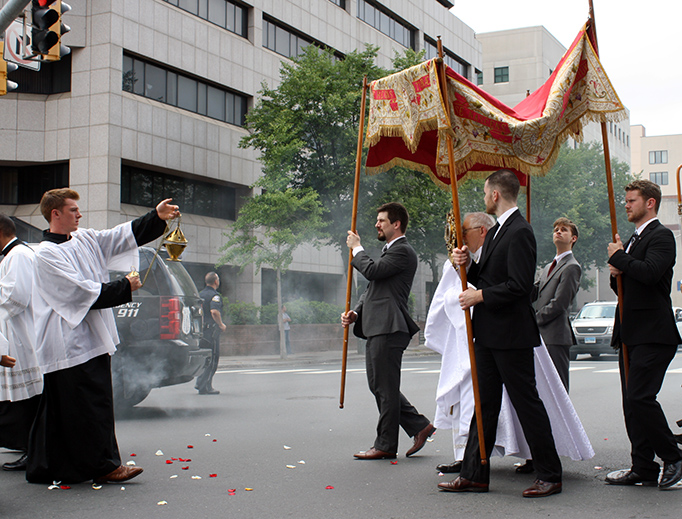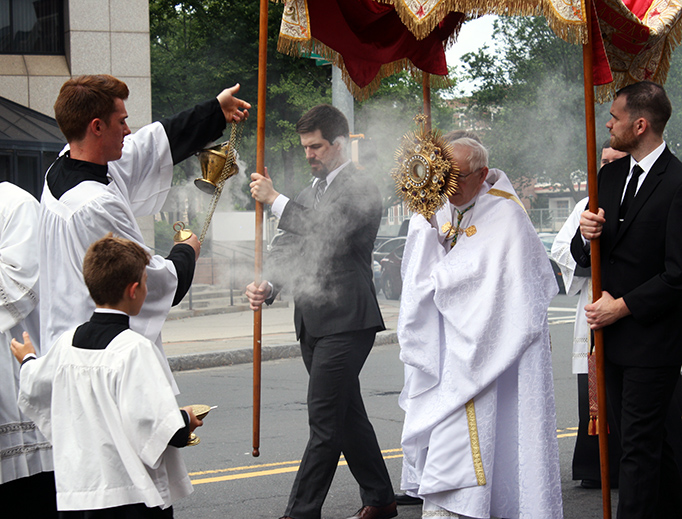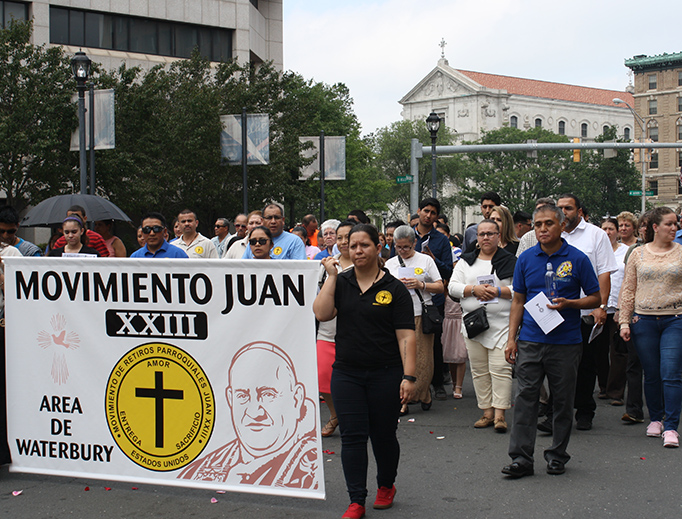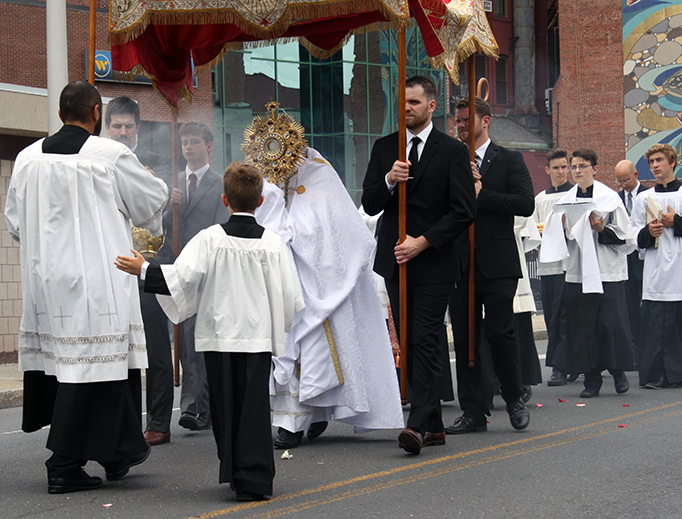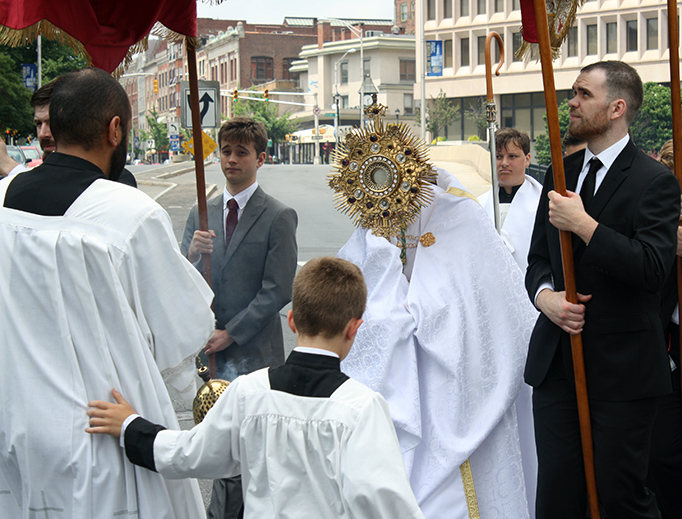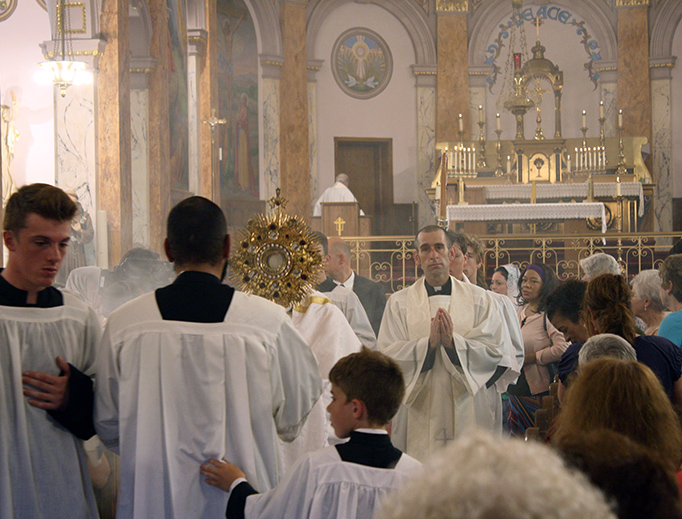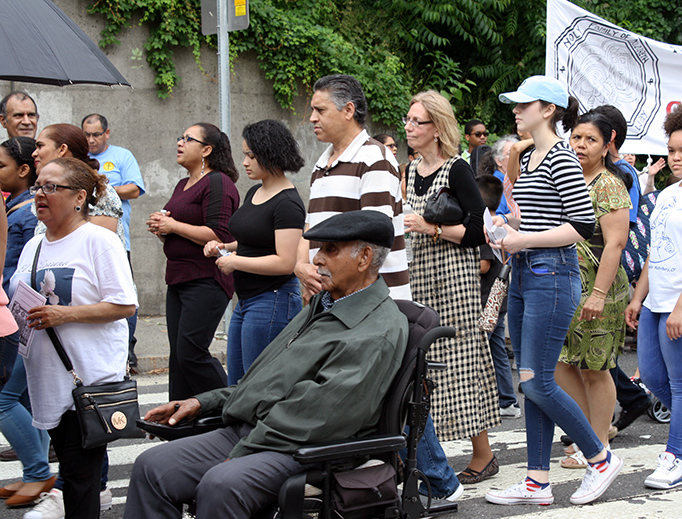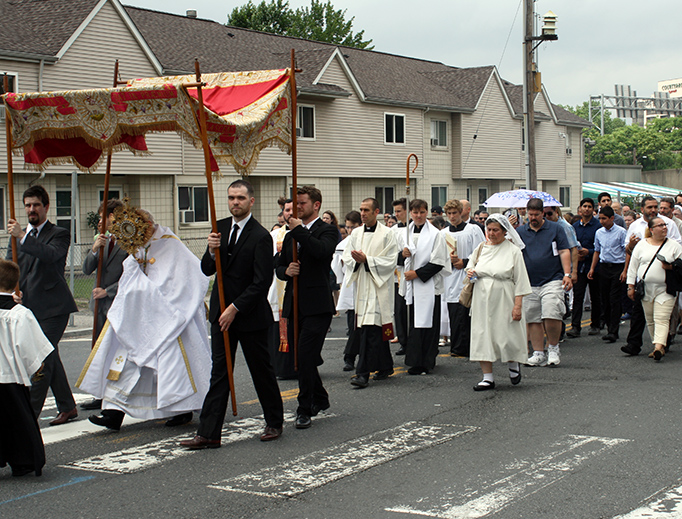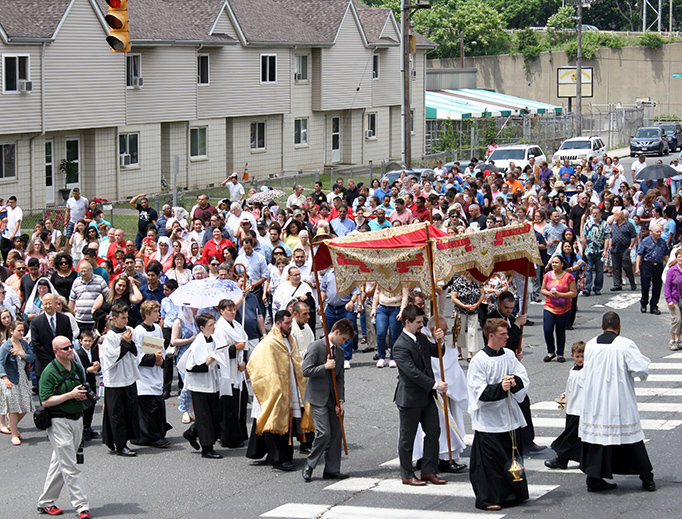Corpus Christi Processions are Making a Comeback
Two Connecticut cities are typical examples of how Corpus Christi processions are starting to make a comeback

In many towns in New England and several other parts of the country, the faith has seen better days especially when we recall their long history of Catholicism and its outward displays — like processions.
But there are signs of a revival. One leader in taking the faith to the streets is the Basilica of the Immaculate Conception in Waterbury, Connecticut. For several years on Corpus Christi Sunday — the Solemnity of the Most Holy Body and Blood of Christ — the basilica has led a procession through the city’s downtown honoring the Blessed Sacrament, then concluded with Benediction. Father Christopher Ford, the rector, said that each year the procession grows. This year was no different.
Again this year, hundreds of people took part in the procession from the basilica after the noon Mass celebrated by Archbishop Leonard Blair of the Archdiocese Hartford. Four priests concelebrated. The archbishop then carried the Blessed Sacrament through the downtown Waterbury in what became a solemn, joyful, moving display of faith taken to the streets.
That reaction was evident from the hundreds who took part in humid, 80 degree weather, to the way other people who happened to be on the streets reacted with reverence, wonder, and even awe as the procession passed along, from seniors to a couple of rough-looking youngsters. Some even knelt down.
What a procession it was, headed by a Knights of Columbus color guard followed by altar servers, nearly 40 seminarians (many from the Legion of Christ), deacons, several priests in vestments, little girls strewing flower petals, the archbishop with the monstrance, more priests and altar servers, then Bridget Froula in her white First Communion dress and Sean MacGillivray in his First Communion suit who were the two children receiving their First Holy Communion from Archbishop Blair at the noon Mass.
Next followed hundreds of people, among them groups carrying banners proclaiming their affiliation, such as the Flame of Love of the Immaculate Heart of Mary, Movimiento Juan XXIII, and the Columbiettes.
Many faithful — young and old, families, even a man in a wheelchair — sang all along the route, familiar songs like O Jesus, We Adore Thee and Lord Who at the First Eucharist, as they processed past the city green just made into a new park, through a downtown block undergoing renovation, into another area already renewed, and to beautiful Our Lady of Lourdes Church, the first stop, to hear a short gospel passage and short reflection on the Eucharist.
Then it was on to the Shrine of St. Anne, a magnificent gothic church where marchers filled the pews, heard another short gospel and reflection on the Eucharist and knelt for the procession’s closing with Benediction. Everything was wrapped in billows of incense and traditional hymns, one in French.
Spiritual Fruits
After the Mass and procession, Archbishop Blair reflected on meanings and aspects of the day, the message of adoration and reverence for the Blessed Sacrament not only on Corpus Christi but all the time. He shared three main insights with the Register.
First, this celebration and procession teaches us “to be always prayerful, attentive, and meditative in the presence of the Blessed Sacrament,” he said.
Second, it reminds us, “We are the Body of Christ, and therefore we also see him in our neighbor… the Eucharist embraces all of us.”
Third, it also highlights a public aspect. Archbishop Blair described how as he carried the most Blessed Sacrament “so close, I thought the eyes of Jesus are seeing the world in our streets. He is present to us. What a beautiful thing.”
Archbishop Blair added, “He is always present in the world. The procession reminds us he is present in the world” and interested in our joys, sorrows, and blessing.
Here was Jesus body, blood, soul and divinity under the appearances of bread, the host, walking through the streets.
Father Ford, the basilica’s rector, has seen hundreds attending in past years too. “I always really try to do these [processions] up and encourage people to participate,” he told the Register about processions on other Holy Days too, such as on Palm Sunday. “It’s an outward sign that represents a deeper reality, an interior disposition.”
“This procession demonstrates our faith in the Blessed Sacrament and our unity in Christ,” he said. “The Eucharist is the ultimate source and sign of our unity in Christ.”
Father Ford hoped to reflect this unity in several ways. He had encouraged other Waterbury parishes to join in, especially those merging into St. Anne’s. “It’s a symbol of the unity of the new parish,” he said, referring to the archdiocese’s new pastoral plan that has several parishes merging. The procession is a reminder the Church is the Mystical Body of Christ.
“Through this procession we’re professing our faith in the Real Presence and we’re also celebrating our unity in Christ because the Eucharist is the ultimate source and sign of unity. So we’re also celebrating our unity sharing in the one bread and one cup and demonstrating that in our participation in the procession.”
Praise from Participants
“The Eucharist is so dear to my heart,” said Jo-Ann Pesino, an extraordinary minister of the Eucharist for several years. The Corpus Christi procession presented yet another way “to love and honor him today, see him as the center of everything and see him so surrounded by hearts so dear.”
Pesino added, “The Eucharist shows not only his love but his humility just to be with us. When I receive him he fills me to the point of my heart burning.”
Her husband Dennis Pesino said it was “good to see so many people who love Jesus come in this hot weather.”
One of the canopy bearers, Thomas Froula, said to him the celebration of the Body of Christ mean grace to get through the day. “That’s what the Eucharist is for,” he said.
Nadine Merancy also was very pleased with the procession. “His heart is truly beating in the Eucharist for us,” she said. “To take Jesus to the streets with that beating heart, I can’t imagine the graces coming down upon us, upon our parishes, and upon the city of Waterbury.”
Merancy added that she looked at Jesus in the monstrance and asked, “Are you happy, Jesus?” He certainly was. And in New Haven too where there was another Corpus Christi procession.
Traditional and Timely
On Sunday, the Corpus Christi procession from St. Peter’s Basilica went through the streets of Rome. In his Apostolic Letter Mane nobiscum Domine for the Year of the Eucharist, October 2004–October 2005, St. Pope John Paul II recommended that Catholics participate in a procession on the Feast of Corpus Christi and taught, “Our faith in the God who took flesh in order to become our companion along the way needs to be everywhere proclaimed, especially in our streets and homes, as an expression of our grateful love and as an inexhaustible source of blessings.”
The custom dates back to the feast of the Blessed Sacrament established in 1246 by the Bishop of Liege, Belgium, after Jesus told St. Juliana of Mont Carvillon she was to promote it. By 1264, Pope Urban IV extended the feast to the whole Church. St. Thomas Aquinas composed the office.
Jesuit Father Francis X. Weiser in his Handbook of Christian Feasts and Customs relates that in the early 14th century the custom began of carrying the Blessed Sacrament after Mass through the town in a beautiful precession. Popes encouraged it and granted indulgences, then the Council of Trent “solemnly approved and recommended the procession on Corpus Christi as a public profession of the Catholic faith in the real presence of Christ in the Holy Sacrament.”
In his 19th century book The Blessed Eucharist: Our Greatest Treasure, Redemptorist Father Michael Mueller details the reason why Jesus told St. Juliana to establish this feast. Given over 700 years ago, they sound current as today. Father Mueller wrote:
He wished it to be instituted for the following reasons:
1st. In order that the Catholic doctrine might receive aid from the institution of this festival, at a time when the faith of the world was growing cold and heresies were rife.
2dly. That the faithful, who love and seek truth and piety, may be enabled to draw from this source of life new strength and vigor to walk continually in the way of virtue.
3dly. That irreverence and sacrilegious behavior towards the Divine Majesty in this adorable Sacrament may, by sincere and profound adoration, be extirpated and repaired.
Lastly. He bade her announce to the Christian world His will that this feast should be observed.
24 Miles Away
On Sunday in New Haven, Connecticut, the Dominicans at St. Mary Church, where Venerable Father Michael McGivney is buried, held a Corpus Christi procession that traveled a mile-long route to St. Joseph Church.
“In essence this was the celebration of the merging of the two churches,” said Dominican Father John Paul Walker, pastor of St. Mary’s and administrator of St. Joseph’s. “Both churches in the archdiocese’s pastoral plan are being combined into one parish.”
Three hundred adults and about 100 children formed this Corpus Christi procession. They joined several priests and Dominicans bothers studying for the priesthood, one already a deacon.
Processing after the crucifix, there were altar servers all ringing bells. “Father Walker reminded that “50 to 60 years ago people hearing the bells knew the Eucharist was on the way.”
Naturally, there was a Knights of Columbus honor guard, children who had made their first Holy Communion this years, and a group of girls all dressed in white and scattering rose petals before the Blessed Sacrament.
Father Walker carried the monstrance under an antique canopy, over 100 years old and decorated with magnificent Eucharistic images. He and associate pastor Dominican Father Elias Henritzy took turns carrying the monstrance along the route.
A number of groups participated too, including the young Columbian Squires and Dominican laity carrying Rosary banners that were over 100 years old. Shuttles brought the elderly unable to make the walk from St. Mary’s to St. Joseph’s so they wouldn’t miss the Benediction.
“The Eucharist is one of the central mysteries of our faith and an incredible gift,” explained Father Walker. “In our modern world even among Catholics,” the appreciation of “the incredible gift it is of our Lord’s body and blood is dwindling some. This [procession] emphasizes this is the King of Kings and Lord of Lords with the incense, bell ringing, and flowers. It’s a means to bring people into the truth this is Our Lord Jesus coming here, and it’s something special.”
Reactions along the way proved the point. People sitting outside several outdoor cafes on the main street stopped in amazement. Children asked parents what was going on, and people came asking those processing the same.
“It was incredible. Very moving,” said Father Walker. With hymns sung the entire way, he described the reaction of people in one car going down the opposite side of the street. They rolled down the car windows and joined in singing the hymns.
There were “lots of real experiences that were very powerful,” Father Walker said. “Catholic or not Catholic, it generated a lot of interest among the people on the streets along our path.”
What Archbishop Blair said in Waterbury applied to these reactions to the Corpus Christi procession, to those in Waterbury, and wherever else they were held — the procession is not just for ourselves, but to proclaim to others.
What did your parish or diocese do for Corpus Christi Sunday?
